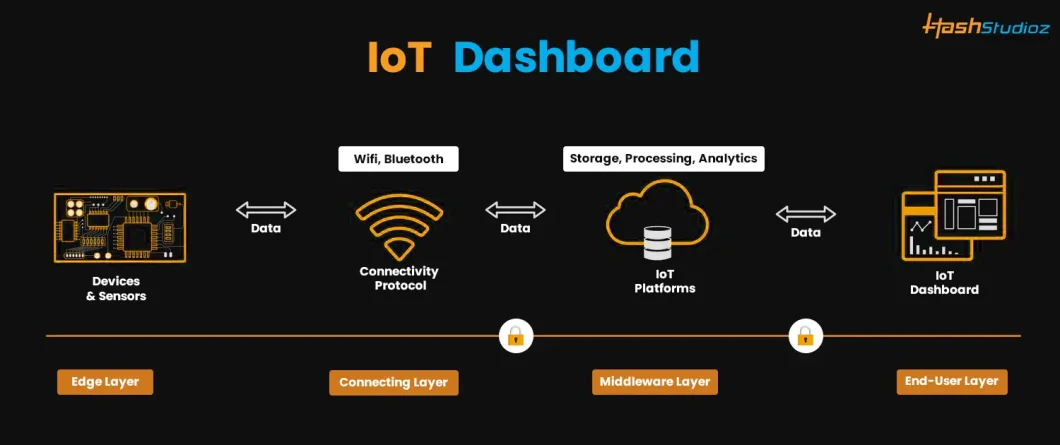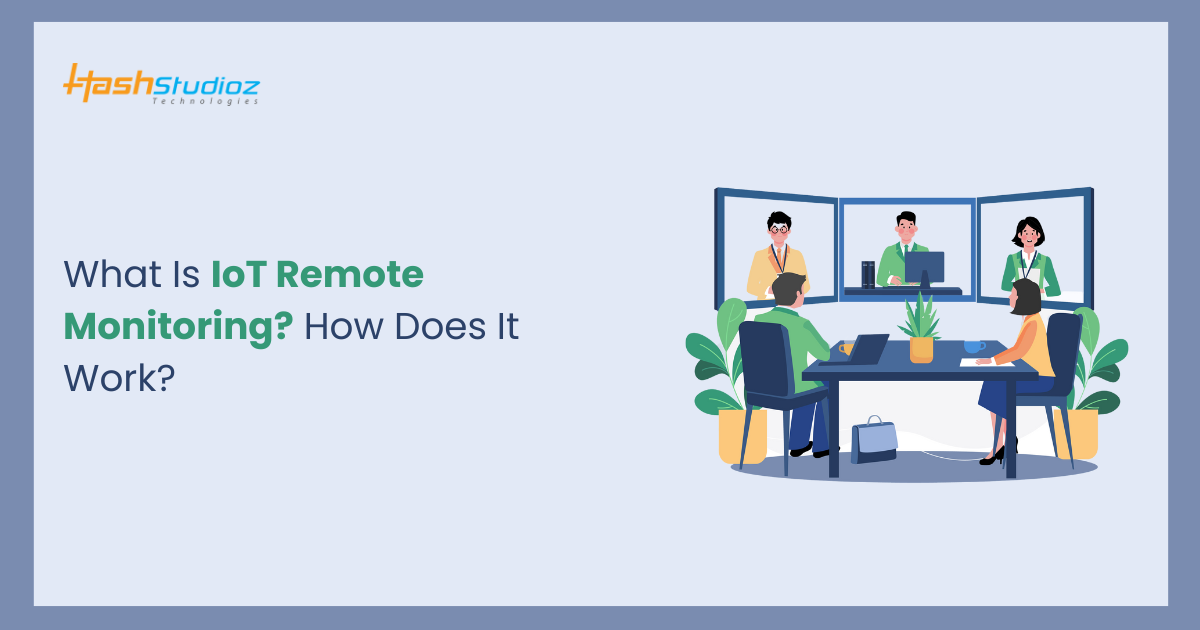When it comes to managing and tracking your assets, it’s essential to ensure you’re employing the most effective strategies and technologies. This is where IoT remote monitoring steps in to provide a solution, demonstrating its capability to optimize operations for businesses regardless of their scale.
In this blog, we’ll present a comprehensive overview of IoT remote monitoring systems: from their definition and functionality to their crucial role in modern asset tracking. We’ll also talk about the real advantages companies get from using advanced technology like this. Get ready to see how easy it can be to manage assets.
Table of Contents
What is IoT Remote Monitoring?
IoT remote monitoring is a technology that enables businesses to remotely monitor and manage assets and infrastructure. This technology depends on connected devices and sensors to collect information about various environmental conditions such as temperature, humidity, pressure, motion, and other factors that may impact the performance of machinery or the safety of individuals in a given location
The data collected by these devices and sensors is then transmitted over the internet to a centralized system for analysis, visualization, and control. The system can be accessed by a team member from any location, allowing them to monitor and manage assets and operations in real time, identify issues as they arise, and take corrective action to prevent downtime, reduce costs, and improve performance.
How Does Remote IoT Monitoring Function?
IoT remote monitoring employs internet-connected sensors and devices to oversee and regulate systems and operations from a distance. This technology enables real-time data collection and control, facilitating prompt responses to system changes.
For example, in industrial environments, IoT remote monitoring can monitor equipment performance, identify issues early on, and allow for remote adjustments, thus preventing production delays.

IoT Remote Monitoring solution consists of four main essential components.
1. Sensors and Devices
These range from basic temperature sensors to advanced devices detecting variables like vibration. For example, in manufacturing, sensors on machinery can detect abnormal vibrations, preventing breakdowns.
2. Connectivity
Utilizing various protocols like Wi-Fi and Bluetooth, connectivity links devices to transmit data. For remote locations, satellite communication may be employed.
3. Data Processing and Analysis
Advanced algorithms, including machine learning, process collected data to derive actionable insights. In energy management, for instance, algorithms analyze usage patterns to optimize performance.
4. User Interface
Interfaces, from mobile apps to IoT dashboards, provide accessible data visualization and control. For smart homes, an intuitive app allows homeowners to monitor and adjust systems.
What are the Components of an IoT Monitoring System?
Typically, a loT monitoring system consists of three main components:
1. Sensors: These act as detectors, measuring parameters such as temperature, motion, or air pollution. They collect data from the environment.
2. Gateway: This serves as a messenger, transmitting data from sensors to the next destination, often a computer or cloud server. It ensures data reaches its intended destination securely.
3. Software: This serves as the system’s brain, analyzing data collected by sensors. It can generate graphs, issue alerts for anomalies, or even control devices based on the received data.

Applications of IoT Remote Monitoring
Many different industries use IoT remote monitoring, and each has its uses and advantages. IoT plays a critical role in improving patient care, operational efficiency, and sustainable practices in various fields, including industrial automation, healthcare, energy management, and agriculture.
1. Industrial Automation
In factory settings, IoT remote monitoring optimizes the entire production process. Sensors track machine performance, environmental conditions, and worker efficiency, feeding data back to a central system for real-time adjustments.
Example: sensors on a conveyor belt can detect speed fluctuations, alerting maintenance teams to potential mechanical issues before they cause significant downtime.
2. Healthcare
Remote monitoring in healthcare ranges from wearable devices tracking vital signs to remote robotic surgeries.
Example: A heart rate monitor worn by a patient can alert healthcare providers to irregularities in real-time, enabling prompt intervention.
3. Energy Management
IoT devices in energy management, such as smart meters and sensors, monitor consumption patterns to optimize energy usage in real-time, reducing costs and environmental impact.
Example: Smart meters in residential areas provide real-time data on electricity usage, enabling utility companies to predict peak demand times and adjust supply accordingly, thus reducing energy waste.
4. Agriculture
In agriculture, IoT involves sensors monitoring soil moisture, weather conditions, and crop health. This data assists farmers in making informed decisions about irrigation and fertilization, leading to better crop yields and resource management.

Example: sensors embedded in irrigation systems can detect soil moisture levels, automatically adjusting water flow to ensure optimal hydration for crops, resulting in more efficient water use and healthier crop yields.
5. Logistics and Supply Chain
In, logistics and supply chain management by providing real-time visibility and control over the movement of goods. Sensors deployed throughout the supply chain track the location, condition, and status of shipments, allowing for proactive decision-making and optimization of delivery routes.
Example: In shipping containers, IoT sensors monitor factors like temperature, humidity, and location, ensuring that perishable goods remain within specified conditions during transit. This helps to prevent spoilage and minimize losses, ultimately improving efficiency and customer satisfaction.
Also Read:- IoT in Education: Smart Classrooms & Connected Campuses
What Advantages Can You Get From IoT Remote Monitoring
IoT remote monitoring offers a multitude of benefits that can transform businesses and operations across various industries. Here are some key advantages:
1. Enhanced Visibility and Control
Gain real-time insights into the status and performance of your assets, equipment, or environment. This allows for proactive management and minimizes the risk of unexpected failures.
2. Improved Efficiency and Productivity
Optimize processes and resource allocation based on data-driven insights from remote monitoring. This can lead to reduced downtime, faster response times, and improved overall operational efficiency.
3. Reduced Costs
Preventative maintenance enabled by remote monitoring helps avoid costly breakdowns and repairs. Additionally, optimized operations through data analysis can lead to cost savings in areas like energy consumption or resource usage.
4. Improved Decision-Making
Data collected through remote monitoring empowers informed decision-making. You can identify trends, predict potential issues, and make data-driven choices for better outcomes.
- Increased Safety and Security: Remote monitoring of environmental conditions or equipment health can help prevent accidents or safety hazards. Additionally, real-time data can improve security measures by providing remote monitoring of assets or access points.
- Scalability and Flexibility: IoT remote monitoring systems can be easily scaled to accommodate growing needs or integrate with existing infrastructure. This allows for a future-proof solution that adapts as your requirements evolve.
- Sustainability: Remote monitoring can promote sustainable practices by optimizing energy use based on real-time data. Additionally, it can facilitate better waste management or environmental monitoring initiatives.
In summary, IoT remote monitoring offers a comprehensive set of benefits that can transform how businesses manage assets, optimize operations, and gain a competitive edge in today’s data-driven world.
Value of IoT Remote Monitoring
The value of IoT remote monitoring is that it helps businesses make better decisions and run more efficiently, especially for service companies trying to do more with less. With IoT remote monitoring, businesses can save money over time by using fewer parts and dispatching fewer field technicians. It also helps prevent costly repairs and equipment failures by spotting problems early.
For example, if something isn’t working right, IoT remote monitoring alerts the right people to fix it fast, avoiding downtime. Plus, it helps service companies plan maintenance ahead of time, reducing unexpected breakdowns and keeping customers happy.
Overall, IoT remote monitoring lets service companies achieve more while using fewer resources, all while providing better service to customers. We’ve helped many customers unlock the potential of IoT with HashStudioz, a leading IoT app development company.

Our experts are here to assist you, whether you’re just starting with remote IoT monitoring, a Real-Time Monitoring Dashboard, or looking to improve your current setup. Our solutions work for various industries, including healthcare, retail, and transportation.
Frequently Asked Questions
Q. Can IoT remote monitoring systems be integrated with existing enterprise software or control systems?
Yes, many IoT systems connect with existing software (ERP, SCADA) for seamless data flow.
Q. What are some real-world examples of how IoT remote monitoring is used in different industries?
Real-World Examples:
- Manufacturing: Monitor equipment health, and predict maintenance needs.
- Agriculture: Track soil moisture, and optimize irrigation.
- Logistics: Track fleet location, and ensure product quality during transport.
- Buildings: Monitor temperature, and humidity for energy efficiency.
Q. How scalable are IoT remote monitoring systems? Can they be easily expanded as my needs grow?
Highly scalable! Add more sensors and devices as your needs expand.
Q. Are there any ongoing costs associated with using IoT remote monitoring, such as data storage or maintenance fees?
Yes, potential costs include data storage fees, software subscriptions, and occasional maintenance.
Q. What are the potential challenges associated with implementing an IoT remote monitoring system in a large organization?
Large Organization Challenges:
- Integrating with legacy systems.
- Ensuring data security across a large network.
- Managing a potentially complex network of sensors and devices.
Q. What types of sensors are typically used in IoT remote monitoring applications?
Sensor Types: Temperature, pressure, vibration, humidity, motion, and many more depending on the application.

